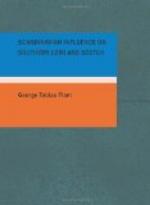than can be inferred from place-names alone.
In the case of early settlements these will generally
represent fairly well the extent of settlement.
But where they have taken place comparatively late,
or where they have been of a more peaceful nature,
the number of new names of places that result from
them may not at all indicate their extent. The
Scandinavians that settled in Southern Scotland probably
at no time exceeded in number the native population.
The place-names would then for the most part remain
unchanged. The loanwords found in Southern Scotch
and the names of places resemble those of Northwestern
England. The same Northern race that located in
Cumberland and Westmoreland also located in Scotland.
It is probable, as Worsaae believed, that it is a
second migration, chiefly from Cumberland. Dumfriesshire,
at any rate, may have been settled in this way.
The settlers of Kircudbright and Wigtown were probably
largely from the Isles on the west. Other independent
settlements were made in Lothian and the region about
the Forth. That these are all later than those
of Cumberland and Westmoreland is probable. According
to what has been said above, the settlements in Dumfries,
which seem to have been the earliest, could not have
taken place before about the second quarter of the
10th Century, and probably were made later. The
other settlements in Southern Scotland may extend even
into the 11th Century. The name Dingwall (O.N.
Ethingvoellr) in Dumfries, the place where
the laws were announced annually, indicates a rather
extensive settlement in Dumfries, and the dialect of
Dumfries is also characterized by a larger number
of Scandinavian elements than the rest of the Southern
counties.
4. SETTLEMENTS IN ENGLAND, NORSE
OR DANISH? THE PLACE-NAME TEST.
That the Danes were more numerous than the Norsemen
in Central and Eastern England from Northumberland
down to the Thames there can be no doubt. The
distinctive Norse names fell, tarn and
force do not occur at all, while thorpe
and toft, which are as distinctively Danish,
are confined almost exclusively to this section.
In Northumberland, Durham, Cumberland, Westmoreland
and Lancashire thorpe is comparatively rare,
while toft is not found at all. On the
other hand, fell, dale, force,
haugh, and tarn (O.N. fjall,
dalr, foss and fors, haugr,
tjoern) occur in large numbers in Northwestern
England. Beck may be either Danish or Norse,
occurs, however, chiefly in the North. Thwaite
Worsaae regarded as Danish “because it occurs
generally along with the Danish by.”
We find, however, that this is not exactly the case.
In Lincolnshire there are 212 by’s, in
Leicestershire 66, in Northampton 26; thwaite
does not occur at all. In Yorkshire there are
167 names in by and only 8 in thwaite,
and 6 of these are in West Riding. It is only




